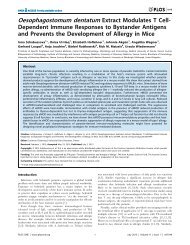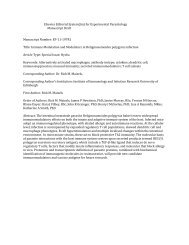Cystatins from filarial parasites - Rick Maizels' Group - University of ...
Cystatins from filarial parasites - Rick Maizels' Group - University of ...
Cystatins from filarial parasites - Rick Maizels' Group - University of ...
Create successful ePaper yourself
Turn your PDF publications into a flip-book with our unique Google optimized e-Paper software.
W.F. Gregory, R.M. Maizels / The International Journal <strong>of</strong> Biochemistry & Cell Biology 40 (2008) 1389–1398 1393<br />
1.4. Analysis <strong>of</strong> genomic structure<br />
All three B. malayi cystatin genes contain three<br />
introns varying in size <strong>from</strong> 120 to 480 bp, which<br />
are located at identical positions within the coding<br />
sequences (Fig. 1C). The number and position <strong>of</strong> these<br />
introns are atypical for known cystatin genes, as they<br />
differ markedly <strong>from</strong> the structure observed in C. elegans.<br />
It is especially surprising that intron positions are<br />
strictly conserved between three B. malayi genes whose<br />
coding regions are up to 75% divergent. Thus, while<br />
the genomic organisation implies that B. malayi cystatin<br />
genes have diverged subsequent to the separation<br />
<strong>of</strong> <strong>filarial</strong> and C. elegans lineages, the coding sequence<br />
phylogeny suggests the reverse. This may indicate that<br />
parasite cystatin protein sequences have undergone rapid<br />
evolution in recent times, possibly as an adaptation to the<br />
parasitic life cycle.<br />
1.5. Differential expression <strong>of</strong> <strong>filarial</strong> cystatins<br />
through the life cycle<br />
While EST information gave some indication <strong>of</strong> <strong>filarial</strong><br />
cystatin levels in different stages, it is important to<br />
verify this with more directed studies. Accordingly, RT-<br />
PCR was employed to detect gene expression throughout<br />
the parasite’s development in both mosquito and mammalian<br />
hosts. Gene-specific primer pairs located within<br />
exons 1 and 4 <strong>of</strong> the genes were chosen to ensure discrimination<br />
between cDNA and genomic amplification<br />
products. PCR <strong>from</strong> cDNA libraries <strong>of</strong> the three main<br />
stages <strong>of</strong> B. malayi suggested that while Bm-cpi-2 is constitutively<br />
expressed, cpi-1 and -3 are more restricted in<br />
their expression to the L3 stage.<br />
A more comprehensive insight is afforded by preparing<br />
mRNA <strong>from</strong> each stage <strong>of</strong> development both during<br />
the vector mosquito (Fig. 2A) and also following infection<br />
in the mammal (Fig. 2B) (Gregory, Atmadja, Allen,<br />
& Maizels, 2000; Murray, Gregory, Gomez-Escobar,<br />
Atmadja, & Maizels, 2001). This analysis shows that<br />
Bm-cpi-2 RNA is indeed present in all life cycle stages<br />
but cpi-1 is only detectable in the late stages <strong>of</strong> parasite<br />
development in the vector mosquito and the very<br />
early stages <strong>of</strong> development in the mammal. Twenty-four<br />
hours after entry into the mammalian host, cpi-1 expression<br />
is seen to fall below the detection limit <strong>of</strong> the assay,<br />
even after 35 rounds <strong>of</strong> amplification, with only marginal<br />
expression at some later time points. Similarly, cpi-3<br />
is predominantly expressed in maturing larvae within<br />
the mosquito, although transcripts <strong>of</strong> this gene can be<br />
detected <strong>from</strong> an earlier timepoint, and are evident at<br />
later mammalian timepoints, than is the case for cpi-<br />
1. It is interesting to note that cpi-1 and cpi-3 genes<br />
are adjacent within the B. malayi genome, organised in<br />
an inverted head-to-head repeat (Fig. 2C). Between the<br />
respective ATG start codons, lie 2.5 kb <strong>of</strong> intervening<br />
sequence which also shows signs <strong>of</strong> a duplication event.<br />
Thus the 500 bp immediately upstream <strong>of</strong> each gene<br />
shows 44% nucleotide identity, suggesting that expression<br />
<strong>of</strong> both cpi-1 and cpi-3 may share some common<br />
promoter elements.<br />
The distinct developmental expression patterns <strong>of</strong> the<br />
cpi genes may give some insight into their respective<br />
functions. The restriction <strong>of</strong> cpi-1 and -3 to the mosquito<br />
stage indicates that their target protease may be <strong>of</strong> insect<br />
origin rather than mammalian. Initiation <strong>of</strong> Bm-cpi-1<br />
expression coincides with L2 moult and the migration<br />
<strong>of</strong> larvae <strong>from</strong> the muscle cells <strong>of</strong> the thorax to the<br />
mouthparts <strong>of</strong> the mosquito (Schacher, 1962). This is<br />
also the time at which larvae become infective to the<br />
mammalian host. Expression <strong>of</strong> the gene is high in comparison<br />
with -tubulin and continues until larvae infect<br />
the mammalian host. Localization <strong>of</strong> the protein at the<br />
surface <strong>of</strong> the larvae suggests that it may be involved<br />
in protection <strong>of</strong> the surface cuticle while the larvae are<br />
resident within the head and mouthparts <strong>of</strong> the vector.<br />
In contrast, the continuing production and secretion<br />
<strong>of</strong> Bm-CPI-2 throughout the mammalian part <strong>of</strong> the life<br />
cycle implies an active role in parasite maintenance. In<br />
the related parasite O. volvulus, the homologous gene<br />
product is highly expressed in the cuticle <strong>of</strong> moulting<br />
larvae, and indeed synthetic cysteine protease inhibitors<br />
are able to arrest moulting altogether (Lustigman et<br />
al., 1992; Richer, Hunt, Sakanari, & Grieve, 1993).<br />
However, there was no detectable increase in cpi-2<br />
transcription around the moulting events, as for example<br />
observed with collagen genes involved in cuticle<br />
synthesis in C. elegans (Johnstone & Barry, 1996). In<br />
contrast, there is ample evidence that the CPI-2 family<br />
are involved in immune interference, as discussed<br />
in the following section. The probability remains therefore<br />
that CPI-2, at least, continues to be important in<br />
the host–parasite relationship after the final moult to the<br />
adult stage.<br />
It should also be considered that multiple functions<br />
for each cystatin would not be unprecedented. For example,<br />
Bm-CPI-1 may also be required for protection <strong>of</strong><br />
larvae <strong>from</strong> host proteases immediately after infection,<br />
or that it plays a regulatory role in the extensive cuticular<br />
changes that are initiated by the infection process,<br />
including the preparation for moulting. Equally, the<br />
expression <strong>of</strong> CPI-2 in the invertebrate vector is likely<br />
to have a functional outcome. In this setting, injection<br />
<strong>of</strong> recombinant Ov-CPI-2 was shown to increase





